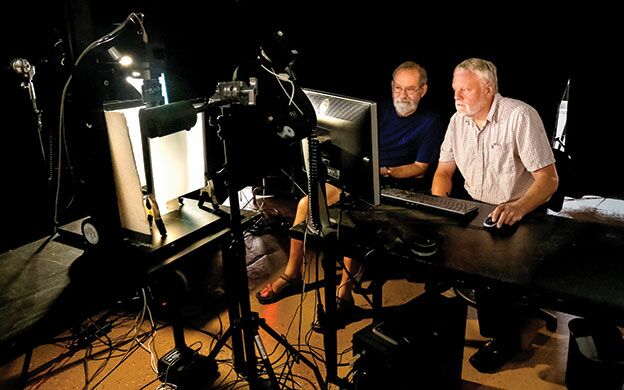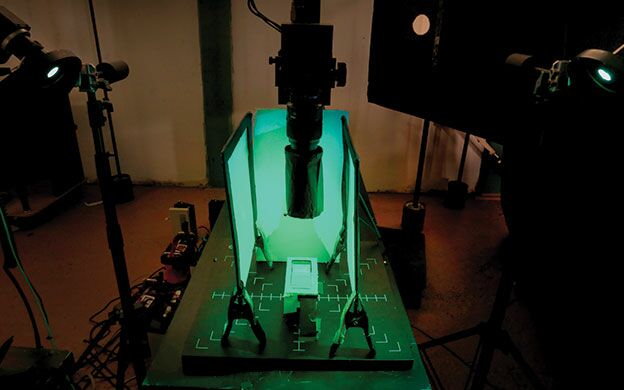Proof of concept: Caravan Beads and Howell Ltd. test new color imaging technology
Barry Kahn and Paul Howell have been in business long enough to qualify as entrepreneurs several times over.
In Kahn's case, as co-owner with his wife of Caravan Beads in Portland, he earned his entrepreneur's stripes by seizing key opportunities that came his way to quickly build what started as a hobby business in 1991 into what is now a successful wholesaler and retailer of multi-colored glass and clay beads used by both amateur and professional jewelry artists from around the world. Howell, a commercial photographer and technology inventor based in Westbrook, became an early adopter of digital photography, opening New England's first digital studio in 1991. With his wife, Colette, he established Howell Ltd. as a studio business doing catalog work for a client list that included Cuddledown, Talbots and Angela Adams and then, after the 2008 recession hit, pivoted by turning his attention to developing multiple technologies related to digital imaging and light science.
Both have learned how to weather the inevitable setbacks — most notably the crash of 2008 — in part by paying close attention to customer service but also by continuing to innovate in their respective arenas. That openness to innovation is what brings them together in a deadline-driven job using Howell's patented Artemis color proofing system to fulfill Kahn's needs for color-accurate images of thousands of multi-colored, multi-shaped beads in his inventory that will be posted on a new website this fall.
A change in vendors for Caravan Beads' website provided the impetus for that project. It comes at exactly the right time for Howell, who is finding it to be a perfect “proof of concept” opportunity to demonstrate the effectiveness of the Artemis system's ability to produce color-accurate images of thousands of small items straight off the camera.
“Barry understands this is a young technology,” Howell says. “It's like a Bath Iron Works ship on sea trials: You just don't know how it's really going to work until you start pounding against the waves … I need to see where the weak links are. This arrangement gave us a chance to do the 'sea trials' with a client who is realistic and understands there are going to be problems that we'll encounter along the way.”
Proving the concept
A former Fairchild Semiconductor executive with an academic background in astrophysics, Howell says the Artemis system tackles the intrinsic problem of color photography dating back to the film era: The fact that it uses just three colors — red, green and blue, or RGB — to replicate the full spectrum of colors visible to the human eye. In the film era, he says, photographers compensated for the inherent color biases of the different film brands by knowing which ones were best suited for particular lighting conditions and subjects and by using filters and lighting as corrective tools. Although digital photography makes it much easier to adjust the camera's color sensitivity even before shooting the subject, there's still a need in high-end catalog work to make color corrections of the images before printing or posting online to make sure they match the color of the subjects being depicted. That adds to the cost.
For Kahn, whose online catalog features literally thousands of beads in various types, colors and sizes, achieving accurate color is more than an academic problem. The Miyuki Delica cylinder-shaped Japanese seed beads sold by Caravan Beads, for example, come in more than 1,100 colors. “Our customers range from the person who doesn't care that much, who says 'Blue is my favorite color' and the range of what is acceptable as 'blue' is very broad, to someone who wants a particular shade of blue and will send the beads back if their color doesn't match what they were looking at on our website when they placed the order,” Kahn says.
Achieving the right color straight out of the digital camera, he says, greatly reduces those “lost in translation” customer complaints — not to mention the added time and expense involved in making refunds and sending a replacement batch of beads with the hope that they'll be closer to the desired color.
Howell says the Artemis system overcomes the limitations of a simple one-shot RGB capture of an image through a patented multiple-shot capture that applies science to the art of color perception. In simple terms, instead of capturing single values for red, green and blue, it provides the equivalent of a RRR-GGG-BBB exposure in one shot for a more nuanced capture of the subject's true color within the continuum of the human visual spectrum.
“As an astrophysicist you get really, really good at understanding light,” he says of the scientific knowledge and curiosity that's spurred his testing and development of a digital photography system that shows promise in cracking the RGB nut for commercial photographers and their clients who require exact color images.
While “multi-spectral imaging” has been around for a while, Howell says it's typically only been “in very high-tech environments.” The goal of his Artemis system is to create an accessible application suitable for commercial photographers doing large quantities of color-sensitive objects (such as the Caravan Beads' job) or which can be used to create quality control color files for package printers or manufacturers of products where color accuracy is critical. He's been working on perfecting the system for three or four years.
What's been lacking, until Kahn approached him this spring to catalog the Caravan Beads inventory for its new website that launches in mid-September, has been the opportunity to prove that the Artemis system works under real-life conditions. By mid-August, they had successfully photographed more than 4,000 different beads with accurate color — with a Caravan employee positioning 2-by-2-inch bead boxes on a copy stand, making the exposure and comparing the image's color on a calibrated computer screen with the original beads.
“We decided early on we need to make Artemis as automatic as possible,” Howell says.
“From their point of view, what we offered when I asked them to take on this job was a huge dataset,” adds Kahn. “We've got lots and lots of products across the full color spectrum that needed to be photographed with color accuracy. It's remarkable good. I'm quite convinced achieving the right color at the very beginning will reduce a lot of [online ordering] problems later on.”
Boosting Maine's 'creative economy'
Both Howell and Kahn see their collaboration as a shining example of how Maine might capitalize on its home-grown talent to build a creative economy based on innovation and collaboration. In their case, using the patented Artemis system to improve the color accuracy of Caravan Beads' website enhances the customer-friendly focus of Kahn's approach to his online wholesale and retail business, while also giving Howell Ltd. an important success story for its new focus as a technology development company.
“One of our goals as a technology company is to put Maine on the map,” says Howell, whose other digital imaging patents include:
- A multispectral imaging device featured in a February 2011 Mainebiz story that can be used by museums and art historians as a non-invasive way of viewing the under-layers of paintings to assist in research or restorations
- An optical silhouetting system that “effortlessly” achieves silhouettes of even the most complex objects and detail
- A contrast enhancement method that eliminates diffraction and enables higher resolution digital imaging.
“We're all in,” Howell says of Howell Ltd.'s pivot from being strictly a commercial photography studio to being a technology/innovation company.
For Kahn, the phrase “all in” accurately describes nearly a quarter century of being in the beads business. “We became a business purely by accident,” he says, describing how the company got its start in 1991 literally on the front porch of his home selling beads on Saturdays, and then moved before the year was out to a rented space on Portland's Brighton Avenue to keep pace with an unexpectedly rapid growth in faithful customers.
“We all had full-time jobs, we were all working for free,” he recalls, crediting an early story in the Portland Press Herald with fueling demand for their beads and helping the company achieve enough sales to stay open six days a week and hire its first paid employee. “We caught the beginning of the huge boom in the beading industry,” he says. “When luck smiles on you, you have to grab your opportunity and run with it.”
That philosophy led to Caravan Beads' move to the more prominent retail location of Portland's Forest Avenue and its later store expansions; its successful move into wholesale in 1995 as a seller of imported Japanese seed beads through Miyuki; its early embrace of having an online presence via its own website; and its expansion into licensing independent retailers who've received training in the Caravan Beads business model.
“I was getting four or five calls a day from people all over the country who wanted to open a bead store,” he says of the latter initiative. “In the middle of the beading boom, I did training 51 out of 52 weekends … It was like a freight train racing down the tracks.”
Like Howell, Kahn says the 2008 crash hit Caravan Beads hard, with many of its bead store customers nationwide being forced to close their businesses. The company survived, in part, by retooling its wholesale packaging (e.g., being willing to sell in smaller quantities) and by maintaining strong customer service.
“Thanks to the Internet and because we're selling to Europe, we had an 'insurance policy,'” Kahn says. “All of our current largest customers are in Europe, not the United States. Our customer base was diversified enough that even though gross revenues were running 50% to 55% of what they were at our peak, we've remained profitable.”
Kahn admits that even with a quarter century of being in business, he's never lost the mindset of being a “startup.” He takes solace in something Mary Ellen Fitzgerald, founder of the Portland market research firm Critical Insights, once told him: “As long as you're terrified, you'll probably do OK. Once complacency sets in, you're dead.”
“I live with terror on a daily basis,” he says, with a smile.












Comments